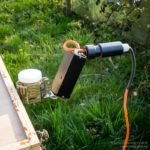Out, damned mites
Today was very mild, slightly damp and breezy after a prolonged cold spell (at least here in Scotland). The long, cold spell means that colonies are broodless†. Now is an ideal time to apply your midwinter Varroa treatment. Don’t wait until the Christmas holidays, don’t wait until the weekend after next … colonies will probably have sealed brood again by then. For maximum effect treat while the colony is broodless and decimate the phoretic mite population.
I treated all my colonies late this afternoon and evening. I finished the last using a headtorch for illumination and tidied up under bright moonlight. The bees looked good and it was great to be doing some beekeeping again, if only briefly.
† A longer post justifying why the colonies were considered broodless and why it is so important to treat when they are broodless will appear this Friday.
The rather weak title is a variant of Shakespeare’s “Out, damned spot” from the play Macbeth. The words are spoken by the sleepwalking Lady Macbeth who is going insane with guilt after her husband killed Duncan (the King of Scotland). The spot refers to Duncan’s blood. Mites on the Varroa tray look like tiny spots of blood …

Join the discussion ...